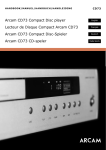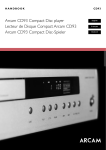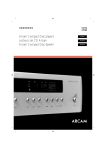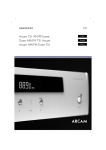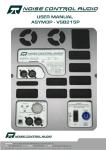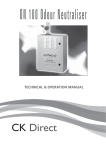Download Handbook Subwoofer Manuel Caisson de basses Handbuch
Transcript
Handbook Subwoofer Manuel Caisson de basses Handbuch Subwoofer Handleiding Subwoofer Manual Subwoofer Руководство сабвуфера Manuale Subwoofer 手册超低音音箱 English Handbook Subwoofer English welcome... contents … and thank you for purchasing the Arcam Solo sub. Arcam has been producing specialist audio equipment of remarkable quality for over three decades and the new Solo sub is the latest in a long line of award winning Hi-Fi and home cinema products. We hope that the care and effort we have put into building this product will be amply demonstrated in its superior performance and reliability, ensuring that you enjoy many years of ownership. This handbook is a guide to installing and using the Solo sub. Use the contents list on the next page to guide you to the section of interest. We hope that your Solo sub will give you years of trouble-free operation. In the unlikely event of any fault, or if you simply require further information about Arcam products, our network of dealers will be happy to help you. Further information can also be found on the Arcam website at www.arcam.co.uk. The Solo sub development team. E-2 safety guidelines E-4 installationE-5 What’s in the box? E-5 Positioning the unit E-5 PowerE-5 Turn on from standby E-5 Care of your speaker E-5 Wireless connection E-6 Solo sub and Solo bar positioning E-6 Wired connections E-7 Solo sub and speaker positioning E-8 calibrationE-9 Crossover frequency E-9 Crossover Q E-9 VolumeE-9 PhaseE-9 specificationsE-10 troubleshootingE-11 product guarantee E-12 Worldwide guarantee E-12 Claims under guarantee E-12 Problems?E-12 On-line registration E-12 E-3 English important safety instructions installation 1. Read these instructions All the safety and operating instructions should be read before this product is operated. 2. Keep these instructions The safety and operating instructions should be retained for future reference. 3. Heed all warnings All warnings on the appliance and in the operating instructions should be adhered to. 4. Follow all instructions All operating and use instructions should be followed. 5. Do not use this apparatus near water The appliance should not be used near water or moisture – for example, in a wet basement or near a swimming pool. 6. Clean only with dry cloth. 7. Do not block any ventilation openings. Install in accordance with the manufacturer’s instructions. 8. Do not install near any heat sources such as radiators, heat registers, stoves, or other apparatus (including amplifiers) that produce heat. 9. Do not defeat the safety purpose of the polarized or grounding-type plug. A polarized plug has two blades with one wider than the other. A grounding type plug has two blades and a third grounding prong. The wide blade or the third prong are provided for your safety. If the provided plug does not fit into your outlet, consult an electrician for replacement of the obsolete outlet. 10. Protect the power cord from being walked on or pinched particularly at plugs, convenience receptacles, and the point where they exit from the apparatus. 11. Only use attachments/accessories specified by the manufacturer. 12. Use only with the cart, stand, tripod, bracket, or table specified by the manufacturer, or sold with the apparatus. When a cart is used, use caution when moving the cart/apparatus combination to avoid injury from tipover. 13. Unplug this apparatus during lightning storms or when unused for long periods of time. 14. Please keep the unit in a well-ventilated environment. E-4 15. Refer all servicing to qualified service personnel. Servicing is required when the apparatus has been damaged in any way, such as power-supply cord or plug is damaged, liquid has been spilled or objects have fallen into the apparatus, the apparatus has been exposed to rain or moisture, does not operate normally, or has been dropped. 16. Caution regarding installation: For heat dispersal, do not install this unit in a confied space such as a bookcase or similar enclosure. WARNING: To reduce the risk of fire or electric shock, do not expose this apparatus to rain, moisture, dripping or splashing. Objects filled with liquids, such as vases should not be placed on the apparatus. WARNING: The mains plug or appliance coupler is used as a disconnect device, the disconnect device shall remain readily operable. What’s in the box? << << << << Solo sub subwoofer Power cord User manual Registration card Positioning the unit This lightning flash with arrowhead symbol within an equilateral triangle is intended to alert the user to the presence of non-insulated ‘dangerous voltage’ within the product’s enclosure that may be of sufficient magnitude to constitute a risk of electric shock. Warning: To reduce the risk of electric shock, do not remove cover (or back) as there are no user-serviceable parts inside. Refer servicing to qualified personnel. The exclamation point within an equilateral triangle is intended to alert the user to the presence of important operating and maintenance instructions in the literature accompanying the appliance. This equipment is a Class II or double insulated electrical appliance. It has been designed in such a way that it does not require a safety connection to electrical earth. Correct disposal of this product This product contains electrical or electronic materials. The presence of these materials may, if not disposed of properly, have potential adverse effects on the environment and human health. Place the Solo sub speaker unit on a level, firm surface, avoiding direct sunlight and sources of heat or damp. Do not place the Solo sub in an enclosed space such as a bookcase or closed cabinet unless there is good provision for ventilation. The unit is designed to run warm during normal operation. Power Turn on from standby Care of your speaker The Solo sub is supplied with a moulded mains plug already fitted to the lead. Check that the plug supplied fits your supply. If your mains supply voltage or mains plug is different, please contact your Arcam dealer immediately. The Solo sub is fitted with a mains power switch on the rear panel, beside the power socket. Make sure it is switched on to use the Solo sub. Running-in Solo sub is fitted with a transformer designed to accept nominal mains voltages from 110-120V to 220-240V. The push-in STANDBY button provides two settings: AUTO and MANUAL. AUTO MANUAL 220-240V~ STANDBY 110-120V~ First of all, make sure the voltage switch is set to the correct setting. Connect the mains cable to the power socket on the back of the Solo sub, making sure that it is pushed in firmly. Now push the plug into your mains socket and switch the socket on. Note: If the unit is to be left unused for an extended period, disconnect it from the mains supply to save power. Presence of this label on the product means it should not be disposed of as unsorted waste and must be collected separately. As a consumer, you are responsible for ensuring that this product is disposed of properly. E-5 AUTO (button out) switches the Solo sub’s amplifier to standby after a period of about 15 minutes when no audio signal has been received. When the unit is in standby the PWR LED will glow red. MANUAL (button pushed in) means that the Solo sub’s amplifier is on whenever the unit is receiving mains power. The PWR LED will glow green. Note: If the INPUT selector is set to WIRELESS, the WIRELESS LED will flash blue intermittently whenever the unit is on standby. It will glow a constant blue when receiving an audio signal or mains power. In the same way as a new car requires a ‘running-in’ period, so do all loudspeakers. Your Solo sub may sound good when you first connect it, but with time it will improve dramatically. It takes about 50 hours of use before its full potential is realised. Cleaning To clean your speaker simply use a soft, slightly dampened cloth to wipe off any dust or dirt. Do not use solvent-based or chemical cleaning products as these may damage the finish of the speaker cabinet. Power handling Arcam speakers are designed to reproduce recorded music under normal domestic conditions. We do not recommend nor warrant them for commercial applications, such as discothèques, public address, etc. English Wireless connection To pair the unit with a Solo bar make sure the unit is turned on at the power switch. 1. Press the button on the remote control unit of the Solo bar followed by until Speaker/EQ Setup appears on the front display panel. Press followed by again, until Sub Pairing appears. Solo sub and Solo bar positioning 3. Position the INPUT selector on the rear of the Solo sub to WIRELESS. WIRELESS LINE LFE We recommend the use of high-quality screened audio cables. Poor quality cables will degrade the performance of your system. All cables should be kept as short as is practically possible. WIRELESS PAIRING PWR 2.Press to start the pairing procedure. The display will change to In Progress. Wired connections 4. Press and hold the WIRELESS button on the rear of the Solo sub for about five seconds. The WIRELESS LED will start flashing blue, signalling that the Solo sub is in sync mode and searching for a It is good practice when connecting your equipment to make sure that the mains power-supply cabling is kept as far away as possible from your audio cables. Failure to do so may result in unwanted noise in the audio signals. WIRELESS 5. If the the pairing procedure was successful, the WIRELESS LED will glow a constant blue and the Solo bar will display Linked. Note: When connecting the Solo sub to audio cables, or when moving it to a new position, make sure that the unit is switched off and disconnect the power lead. Failure to do so may result in damage to both speaker and amplifier. 6. Once the pairing procedure is finished, the Solo sub will always reconnect whenever it is powered on or receives an audio signal. INPUT Subwoofer/satellite system This is a multi-speaker system comprising of two or smaller satellite speakers (or a soundbar) coupled with a subwoofer. The satellite speakers are defined as ‘small’ and are responsible for reproducing higher frequency audio signals; while the subwoofer reproduces the lower frequencies where the smaller speakers are not capable. of your speakers which may vary from around 70Hz for large satellites, to 150Hz for small speakers. We recommend 85Hz as a starting point if you are unsure. WIRELESS LINE LFE Stereo system with no LFE This is a typical two-channel system (such as an Arcam stereo amplifier). If your sound source does not have SUB or LFE outputs, connect the right and left channels of the stereo pre-amp outputs (PRE OUT L and PRE OUT R) to the red R and white L/LFE inputs respectively. PRE-OUT R INPUT If your sound source has an output marked SUB, SUBWOOFER or LFE, connect it to the white L/LFE input on the back panel of the Solo sub using an RCA connector at each end. R L/LFE PRE-OUT L L/LFE Make sure the INPUT selector is set to LINE. The crossover frequency on the Solo sub should be adjusted to the low frequency roll off of the main speakers (see the manual for your speakers for this information). The Q-control (X-OVER Q) can be used to finetune the integration of Solo sub and your main speakers (see page 8 for information). SUB Make sure the INPUT selector is set to LFE. The LFE input bypasses the crossover in the Solo sub, so the crossover frequency should be set by the surround sound amplifier. For the crossover setting, please see the response Solo sub recommended settings WIRELESS LINE 85 100 115 0.9 125 70 0.5 Note: Sync mode lasts for about 30 seconds. If no source is detected during this time, the Solo bar will stop searching and the process will need to be repeated. 50 1.3 160 X-OVER FREQ 0˚ 6 3 1.5 0.3 X-OVER Q 180˚ 7 2 8 9 1 140 35 4 1.1 0.7 5 10 0 VOLUME PHASE For Phase settings, please refer to the information on page 9. E-6 Note: The wired connection will not work if the Solo sub has been previously linked to a Solo sub using wireless connection. To disable the wireless connection, place the Solo bar to its factory default settings. Refer to the Solo bar user manual for how to do this. LFE INPUT E-7 After connecting Turn the volume down to minimum on the sound source amplifier before switching it on. Switch the source amplifier on, select a source signal, then gradually increase the volume to the required listening level. English calibration Solo sub and speaker positioning The advice given here is a general guideline for setting up speakers. Refer to the documentation supplied with your speakers for more precise information. Visit www.dolby.com for usefuI information on listening-room layouts. Speakers should never be placed on the floor (unless they are floor-standing speakers), or in corners. Speaker drivers should be at, or a little above, ear level when seated. If possible, centre your seating area between the surround speakers. Room acoustics Sound will depend on the acoustics of the listening room so experimenting with speaker positioning is very worthwhile. Your room’s shape and how it is furnished will affect the sound you hear. For instance, too many bare surfaces may cause a harshness to the sound. Carpets, wallhangings and curtains can all help. If you have a choice of listening rooms, avoid one that is perfectly square or has one dimension exactly twice another. Such a room can aggravate resonances that colour the sound. The closer you place a speaker to corners and the intersection of wall and floor or wall and ceiling, the stronger the bass output, which may over-emphasise the bass. Moving a speaker just a few inches can sometimes make a big difference. Speaker setup Proper speaker placement is the key to achieving the best home theatre sound (see diagrams). As a rough guide, speakers should be placed on rigid stands about 15cm from the rear wall and at least 60cm from any side wall. L C The Solo sub has two roles: firstly to reproduce accurately and with sufficient power the sub-bass that other ‘smaller’ speakers cannot; and secondly to reproduce the ‘.1’ or low frequency effects (LFE) track of 5.1 or 7.1 material. R 0˚ For optimum results, the Solo sub must be set up in the correct relation to the other speakers in your system. The two relevant controls are the crossover point and the volume level. The crossover point establishes the frequency below which signals are redirected away from ‘small’ speakers toward the subwoofer. Setting the volume level ensures signals that are of equal volume achieve the same sound pressure level no matter what frequency they are or which speaker they come from (i.e. subwoofer or satellite speaker). In most surround-sound systems, two crossovers are available: one in the surround-sound decoder and one in the Solo sub. 22˚ 30˚ Subwoofer The location of the Solo sub will affect the overall sound quality. Placing it next to a wall or in a corner will often boost efficiency and give a cleaner low bass sound. However, all rooms react differently and we recommend that you experiment with positioning by allowing at least 15cm clearance between the walls and the unit. 90˚ RS LS Speaker stands The more firmly a speaker is held, the better it will sound. We recommend the use of rigid metal stands of 40–60cm height. 110˚ Solo sub used with a home cinema Ensure that the stands and/or speakers do not wobble. Properly damped stands that do not ‘ring’ when tapped with a pencil, will bring out the best in a speaker. E-8 To get the optimum sound in a variety of systems, the Solo sub allows these controls to be used independently for systems with ‘Large’ front speakers and an LFE output from the surround-sound decoder. Crossover frequency Crossover Q Volume Phase In most systems, a X-OVER FREQ point of 85 is recommended. The X-OVER Q setting controls the slope of the trace beyond the cutoff frequency, in dB/octave. As a rough guide, a X-OVER Q setting of 1.1 is recommended. Accurate volume setting for a subwoofer ideally requires specialist measuring equipment such as a Real Time Spectrum Analyser or RTA. A regular Sound Pressure Level (SPL) meter will not work for this! The PHASE button has two settings: 0° (button out) and 180° (button pushed in). If your speakers are very ‘small’ (and thus cannot reproduce much bass) you might like to set the crossover point higher than this figure to allow the Solo sub to do more of the work. However, be aware that the higher the crossover point, the more directional the low frequency sounds, thus the more easily identifiable is the subwoofer’s physical position. If your speakers can reproduce reasonable bass, you can try a lower crossover point. Experimentation and listening will guide you to the right spot. The aim is to make a ‘mirror image’ match with the slope of the high-pass filter. A steep cut-off of the high-pass filter from the sound processor/receiver should be matched by a steep cut-off of the low-pass filter from the Solo sub. Similarly, if the sound processor/receiver provides a more gradual cut-off, the X-OVER Q setting should have a lower value. 0 0 -12 -12 20 40 60 80 100 Crossover frequency Hz 120 140 Q=1.5 Q=1.0 Q=0.7 Q=0.6 Q=0.5 Q=0.3 160 Crossover frequency E-9 For most systems though simple experimentation by ear will suffice. Start with a medium setting (6) and experiment with VOLUME until low frequency sounds can be heard as part of the main sound and not traceable to the subwoofer directly. Most sound processors or receivers allow Sub levels to be trimmed ‘on the fly’ to counter excessively high or low levels from particular source material. A phase delay may be used to counteract the effect of sound waves from the Solo sub interacting with and partially cancelling out or unduly emphasising sound from the satellite speakers. This effect depends critically on the relative positioning of subwoofer and satellite speakers and can also be remedied by relocating the subwoofer a short distance. The phase setting is available if relocation is not possible or impractical. English specifications troubleshooting Here are some simple checks you can do if you are experiencing problems with your Solo sub. Note that all specification values are typical, unless otherwise stated. System design One-way speaker with 10 litres internal volume. The cabinet is solidly constructed from machined MDF with internal bracing. Drive unit 10” (254mm) subwoofer drive unit with long excursion, magnetically shielded. Frequency range 20Hz to 250Hz. Impedance 4Ω nominal. Sensitivity 85dB/watt measured at 1m. Crossover Fourth order Linkwitz-Riley crossover circuit, 24dB/octave (80dB/decade), adjustable for frequency and Q. Wireless connections Proprietary 2.4GHz wireless connection to a Solo bar Wired connections RIGHT and LEFT/LFE inputs: RCA phono sockets (Gold), max 2.5V, >22Ω. Mains supply 110-120V / 220-240V at 50/60Hz. Amplifier 300 watts/4Ω, under normal operating conditions, 380W max. Finish Dark grey paint. Dimensions (W x D x H) 320mm x 320mm x 435mm Weight (Packed) 14kg (Note: take care when lifting the unit). E&OE NOTE: All specification values are typical unless otherwise stated. Power << Check that the power cord is plugged in and connected properly. << Make sure the power and mains switches are turned on. Sound << If wirelessly connected, make sure the input selector is set to WIRELESS and the unit is paired with the Solo bar. << If connected by cable, make sure the cables are connected properly and the corresponding input is selected (LINE or LFE). << Make sure the volume settings are not set too low. Continual improvement policy Arcam has a policy of continual improvement for its products. This means that designs and specifications are subject to change without notice. E-10 E-11 product guarantee Worldwide guarantee Claims under guarantee Problems? On-line registration This entitles you to have the unit repaired free of charge, during the first two years after purchase, provided that it was originally purchased from an authorised Arcam dealer. This equipment should be packed in the original packaging and returned to the dealer from whom it was purchased. It should be sent carriage prepaid by a reputable carrier – not by post. If your Arcam dealer is unable to answer any query regarding this or any other Arcam product please contact Arcam Customer Support at the address below and we will do our best to help you. You can register your product on-line at www.arcam.co.uk. The Arcam dealer is responsible for all after-sales service. The manufacturer can take no responsibility for defects arising from accident, misuse, abuse, wear and tear, neglect or through unauthorised adjustment and/or repair, neither can they accept responsibility for damage or loss occurring during transit to or from the person claiming under the guarantee. No responsibility can be accepted for the unit whilst in transit to the dealer or distributor and customers are therefore advised to insure the unit against loss or damage whilst in transit. Arcam Customer Support Department, Unit 15, Pembroke Avenue, Waterbeach, CAMBRIDGE, CB25 9QP, England or via www.arcam.co.uk. The warranty covers: Parts and labour costs for two years from the purchase date. After two years you must pay for both parts and labour costs. The warranty does not cover transportation costs at any time. E-12










